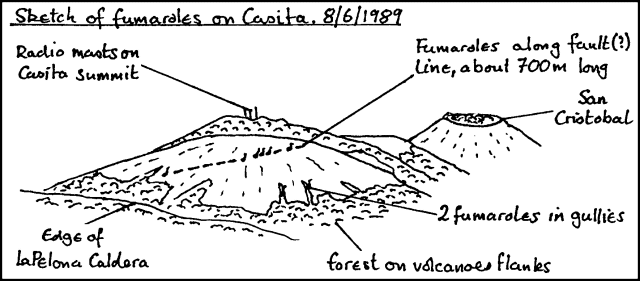Report on San Cristobal (Nicaragua) — June 1989
Scientific Event Alert Network Bulletin, vol. 14, no. 6 (June 1989)
Managing Editor: Lindsay McClelland.
San Cristobal (Nicaragua) New fumaroles along fissure on SE spur of Casita
Please cite this report as:
Global Volcanism Program, 1989. Report on San Cristobal (Nicaragua) (McClelland, L., ed.). Scientific Event Alert Network Bulletin, 14:6. Smithsonian Institution. https://doi.org/10.5479/si.GVP.SEAN198906-344020
San Cristobal
Nicaragua
12.702°N, 87.004°W; summit elev. 1745 m
All times are local (unless otherwise noted)
Previously unobserved fumarolic activity on the SE spur of Casita (at sites 150 m and 0.5-1 km below the communications complex on the summit) was noticed on 8 June. Area residents report that the activity has been present for some time. Emissions appear to originate from a N-S fissure (figure 1). Casita was last reported active in the l6th century.
 |
Figure 1. Oblique sketch of Casita, its fumaroles, and neighboring volcanic features, 8 June 1989. Courtesy of B. van Wyk de Vries and O. Castellón. |
Geological Summary. The San Cristóbal volcanic complex, consisting of five principal volcanic edifices, forms the NW end of the Marrabios Range. The symmetrical 1745-m-high youngest cone, named San Cristóbal (also known as El Viejo), is Nicaragua's highest volcano and is capped by a 500 x 600 m wide crater. El Chonco, with several flank lava domes, is located 4 km W of San Cristóbal; it and the eroded Moyotepe volcano, 4 km NE of San Cristóbal, are of Pleistocene age. Volcán Casita, containing an elongated summit crater, lies immediately east of San Cristóbal and was the site of a catastrophic landslide and lahar in 1998. The Plio-Pleistocene La Pelona caldera is located at the eastern end of the complex. Historical eruptions from San Cristóbal, consisting of small-to-moderate explosive activity, have been reported since the 16th century. Some other 16th-century eruptions attributed to Casita volcano are uncertain and may pertain to other Marrabios Range volcanoes.
Information Contacts: B. van Wyk de Vries and O. Castellón, INETER, Managua.

